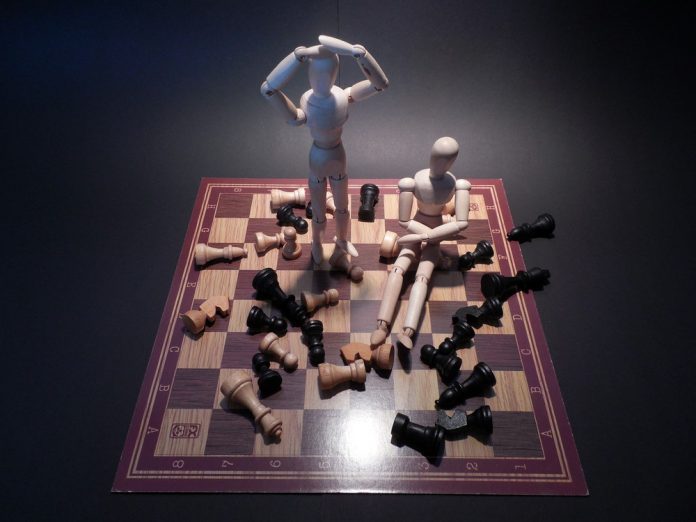You are having a great conversation with a potential new alliance/customer (herein known as “The Newbie”) and have provided a very simple solution that addresses her needs. The Newbie says, “Wow your solution seems like the easiest to understand and I really can see it being of great value to me and my company specifically for our needs.” You reply, “That is wonderful, and I am so excited to help you implement.” You both agree that you are right for each other. It seems like a match! Then something goes terribly wrong. The Newbie remembers past negative experience, begins to worry about how to implement the change, and makes a negative association with the way you are looking at her. She begins to ask deep probing questions that relate to her perception of your solution, and her prior belief of your intentions, character, ethics and what you have to offer. You answer all of her questions quickly and it seems the more you answer, the more she looses belief in you. She is creating her own reality and begins to retreat from the conversation. You now have come to a completely different outcome based on pre-existing assumptions, and sensory reactions about you, your solutions and answers. The conversation and probability of partnership comes to a screeching halt all because of prior beliefs.
What went wrong?
During this downward spiral, the Newbie and you have just imbalanced the equation of Bayes Theorem, an equation formed by Reverend Thomas Bayes, English statistician, philosopher and Presbyterian minister, in the mid 1700s that shows how new evidence through senses, environment, or perception changes beliefs instantaneously.
Theorem spelt out in blue neon at the offices of Autonomy in Cambridge.
For proposition A and evidence or background B:
- P(A), the prior probability, is the initial degree of belief in A. This is the place where you and The Newbie were at during the peak of your conversation where you were close to gaining consensus.
- P(A|B), the conditional probability, is the degree of belief in A, having taken Binto account. This is where you and the Newbie began to spiral down into a decision not to work with each other.
- the quotient P(B|A)/P(B) represents the support B provides for A. This is the point of inflection where you and the Newbie can make the most difference in helping change each other’s perception through co-creation and rebundling of perception, senses, and emotional response.
The Action-Perception loop shows how this conversation unfolded.
The small almond shaped organ in both of your heads, called the Amygdala becomes “hijacked” with emotion and you slow your response and begin to come to alternate conclusions about your possibilities together. You have both come to the “unthinking response” on the diagram below.
Now, let’s rewind and provide solutions for what to do in the future instead. How do you avoid the Amygdala highjack that occurs and throws off Bayes theorem which is responsible for both of your success!
Reverend Bayes, let’s get these two crazy kids back together again!
Your conversation begins with some questions of each other. Tell me about yourself and what you most want to see in the world; for yourself, your family, your organization, and the world. What are your passions? You take equal air time answering these questions to begin the process of mutual respect and caring about each other’s perceptions and world views. You both find commonalities in those you love, the wishes you both have to make the world more understanding and open, and the way in which you would like to really transform others to develop and grow. You begin to form a strong foundation for mutual growth. Next you take equal air time on the question, “What is the one area, project or goal that you believe you would like to be helpers and supporters in each others success?” You both answer the question; again with equal airtime. For you, it is enabling a success case for every client with whom you work and sharing this with the world. You want results with every client. And, you want to work with people who desire to change and help others change. For the Newbie, it is helping the organization change to a specific desired result. You both come to some more questions here: You ask, “What results do you want to achieve?” “What does it look like for you?” “What does success look like for you.” You give her air time to share. Then you move to possibilities. What are some possibilities for helping each other achieve our goals. You place three possibilities on the table. One of these makes sense and is attainable to both of you. You place this possibility on a screen share to show what you both have co-created. Then you decide on the best date for your next conversation where you will discuss the terms of your partnership where you will deploy the same conversation method above.
What have you just done differently?
1. You created a common lexicon/language for understanding each other
2. You started a process of respectful mutual communication through shared airtime.
3. You discussed what success looks like for you and focused on the present and future.
4. You created together (co-created) rather than just selling or telling each other what you want to happen.
5. You moved together to a solution rather than directing each other to a solution.
Keep in mind: co-creation can also bring out personal truths. You may find your collective competencies are not complimentary, or that you are looking or searching for different things. Many things come out of a real, truth-driven, co-creative conversation. In the event of an “unfit” it is good advice to find some way of helping the other person: recommend and connect them someone else who may be a better fit, or find ways to part and detach with respect.
My mentors Warren Bennis, Chris Argyris and Phil Harkins taught me a simple four stage approach for breaking down the barriers of this kind of conversation that I have applied in the above scenario:
1. What’s up (e.g., who are we and what is leading us to be here),
2. What’s so (e.g., What are our assumptions and perceptions of our experience together,
3. What’s Possible (What are some of the possibilities for us to work together),
4. What’s Next (e.g., What are our next action steps); and
5. Let’s Go (e.g., let’s execute on it).
The Ladder of Inference developed by Chris Argyris works off of these 5 steps as a model for the inferences we make during a conversation from observable data and experiences to taking actions based on beliefs that you have formed as a result of your co-creation conversation above. We move up and down the ladder of inference very quickly. However when there is shared language, expectations, experience, and expertise, then co-creation becomes much less challenging.
You may move up and down the pyramid and ladder during your conversation to continually break down assumptions and sensory responses to help yourself, your relationships, teams, and organizations become more successful. I am grateful for my late mentor Chris Argyris and Warren Bennis for their contributions to the world and for helping to reduce fear, flight, and reaction that is causing breakdown in progress in governments, social systems, and organizations throughout the globe and to the Reverend Bayes who started us thinking: Is it my game or brain that is getting in my way?










